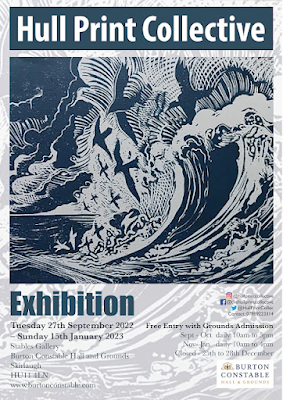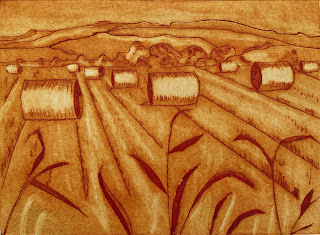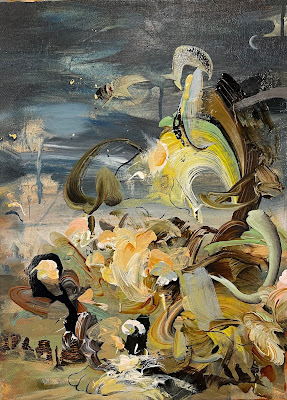Hull Print Collective Exhibition, Burton Constable Hall, East Yorkshire
Saturday, December 31, 2022
Hull Print Collective Exhibition, The Community Gallery, Burton Constable Hall, East Yorkshire
Friday, December 30, 2022
Artist's Statement
Artist's Statement
VISUAL ARTIST
ARTIST’S STATEMENT
I am interested in the cultural landscape of my area; the way human activity and the environment interact and develop. Forces of nature, the power of the sea and the flow of rivers are inherent in understanding the geography of the Humber Region. Industry, housing, and leisure impose themselves onto the evolving landscape. Where human intervention has taken place, it often harmonises with nature. Bridges, lock gates, warehousing and bollards line the route of the Humber Estuary and its tributaries. Newer structures are built, and our industrial heritage becomes part of the geology of the area. I am inspired by these themes along with human stories, writing, and poetry. The play of light and tonal qualities are important to my work. Along the estuary the land is flat, and there are huge skies. Bright light creates deep shadows. Reflections ripple on broad waters, colours sparkle on structures, and silhouettes form against flat fields. Dark skies are menacing, and colours change with the seasons. Often, I use light to create a narrative with a haunting or eerie atmosphere. Edges dissolve and ambiguities emerge by what comes out of the darkness. Tension is created between space and areas of activity, the ins and outs of a painting, the close-ups and what is far away. I engage with oil paint to explore these themes and express my emotions, using brushes and tools to capture movement and texture. The paint’s rich colour and versatility allow me to speak through the images I create. Sketches, tonal underpaintings, and layers of paint build up organically into my own interpretation of what I see and feel. I embrace my surroundings by making sound and video recordings on site which enhance the experience. My paintings capture the light, the moment, have elements of memory and nostalgia, but also speak of today.
December, 2022
Tuesday, November 29, 2022
Paint Edgy Contemporary British Painting Exhibition
Paint Edgy Contemporary British Painting Exhibition,
The Ropewalk, Barton upon Humber, North Lincolnshire
September-November, 2022
The Exhibition, overview
I visited the CBP Exhibition "Paint Edgy" open event and artists' talks on 15 October 2022. I took the general photographs of the gallery and the artworks shown below.
Friday, November 18, 2022
Local Exhibitions Hull City Centre
Exhibitions Hull City Centre:
WHALERS: Moby Dick Remastered in Print by Richard Lees
Wednesday, November 16, 2022
Visit to the Bloomberg New Contemporaries 2022 Exhibition, Ferens Art Gallery, Hull
Visit to the Bloomberg New Contemporaries 2022 Exhibition, Ferens Art Gallery, Hull
 |
| Andre Williams, Room for Doubt, 2021, installation Innovative new work |
Room For Doubt is an installation developed from Williams’s drawings of fantastical rooms. His playful use of unexpected materials draws
the viewer into his world. Masks and mirrors are recurring motifs within the
room. A pair of bespoke Flamingo and Woodpecker wallpapers flanks the room, intensifies the space and plays with perspective. I felt that the room had a "retro" feel and was very three dimensional.
Meitao Qu
Qu’s practice is concerned with how forms of visualisation operate as ‘props’ to stimulate imaginations. Currently, her research examines the visual economy of the cityscape as a symbol of progress. Using miniatures and ready-mades, her work considers the artifice of the built environment to explore the conditions of what is lost and gained in the processes of urbanisation. She contemplates the interplay between ideologies and realities. The installation shows a miniature replica of the Temple of Heaven constructed with building blocks. The sculpture is displayed on a rock-like formation decorated with other architectural models and artificial greenery.
Abi Ola
Ola specialises in oil paint, fabric collage,
installation, and photography. Her work focuses on family portraiture which allow the audience to place
their own loved ones within the portraits. The
combination of tribal and modern-day patterns challenge assumptions
about what ‘primitive’ art is, and whether there are many differences to the
symbols used today in text messages and social media.
Divya Sharma
Sharma is a multidisciplinary artist and textile practitioner whose practice reflects her lived experience. At its heart is
the idea of hybridity and the naive insistence that inter, and
intra-nationalities can do more, they can make futures in which we are not
opposites but "extensions, additions, alloys, alchemical integrations, and
disjointed unifications". As an
immigrant within India and outside, her work draws upon the entanglements that
a hybrid nation(ality) entail.
Conclusions
The New Contemporaries show was very different to the works by Winslow Homer at the National Gallery in London (see previous post). The Homer exhibition consisted solely of paintings which were displayed on gallery walls in a traditional, sequential setting. The subject matter of the Ferens exhibition was diverse, ranging from installations to tapestry. The works represented current issues which the artists were concerned with, and the curation was imaginative to reflect the different approaches. The Ferens approach encouraged the viewer to participate and interact with the ideas put forward by the individual artists. I could walk in and around the rooms and consider the works from different angles, experience a 3D effect and appreciate the perspective of, for example, Andre Williams's "Room".
Monday, November 14, 2022
Visit to the National Gallery, Winslow Homer: Force of Nature
Visit to the National Gallery, Winslow Homer: Force of Nature
Winslow Homer, 'The Gulf Stream', 1899 (reworked by 1906). The Metropolitan Museum of Art, New York.
I recently visited London and went to see the Winslow Homer: Force of Nature Exhibition at the National Gallery. The exhibition was organised by the National Gallery and The Metropolitan Museum of Art, New York.
As the National Gallery states, "From his sketches of battle and camp life, to dazzling
tropical views and darker restless seascapes, the works reflect Homer’s
interest in the pressing issues of his time; conflict, race, and the
relationship between humankind and the environment – issues still relevant for
us today".
Winslow Homer, 'The Veteran in a New Field'
1865
This poignant image of a man (identified as an ex-soldier by his discarded jacket) speaks about hope for the future but also reminds us of the recent violent and divided past.
After the war, Homer’s subject became the lives of Americans
in the wake of the war and abolition with a focus on the lives of formerly
enslaved African Americans.

Winslow Homer, 'Snap the Whip',1872
Snap the whip is a childhood game played outside with teams. Here Homer creates a nostalgic image of carefree, rural life.
Homer travelled to France, England, the Bahamas, Cuba and Bermuda. In England, he stayed in Cullercoats on the North East coast and painted scenes of hardship, heroism and resilience. He was particularly interested in the vision of the strong English women fisherfolk he saw there.
Winslow Homer, 'Inside the Bar' 1883
Northeaster is one of several paintings on marine subjects which Homer created during his time in Maine. The seascape and movement of the waves was powerful, but I thought a little static.
Conclusions
I considered that the galleries were well laid out. They followed a chronological order in a traditional manner. The approach suited the subject matter as it allowed the periods and themes to be explained in well communicated information on the walls of each gallery which one could read and digest whilst walking through the rooms and viewing the works.
I thought that the experience added to my knowledge of realist painting in the United States during this period. I was inspired by his sea views and his sympathetic portrayal of people.
Wednesday, October 26, 2022
Sketching En Plein Air Blacktoft and Yokefleet
Sketching En Plein Air Blacktoft and Yokefleet
A line of poplars near Blacktoft.
I sat in the car and painted this view. It was early spring. I chose yellow ochre to capture a sense of the season. I had been reading about the artist Lois Dodd (American, born 1927) who works entirely in front of the subject to capture the light at the time she sees it - and before it changes. She quickly sketches the scene on masonite boards in yellow paint to begin with, which she thinks is a good colour because it makes it easier to alter the image if necessary.
Fence near Blacktoft.
A charcoal sketch made whilst sitting in the car. I think that the small sketch has a sense of immediacy.
Barn, Yokefleet.
A view of the barn as seen from my car. The barn was huge and there was a strange looking red metal container beneath it. The bright red stood out from the rest of the more natural colours.
The sketches I made whilst sitting in the car gave me the
opportunity to experience making observational sketches in relative privacy
whilst also being “on site” and taking in the atmosphere. I also got out and
took a series of photographs. The exercise demonstrated the benefits of
spending more time in a place whilst working on a drawing or watercolour
sketch. It allowed me to soak up the feeling of a place more than just taking
photos. The memory also seemed to linger on better in my mind.
I found that the angle of the view was different to what I
would have done from a photograph. Sitting in the car I was at a low angle and
the view restricted. If I had done a painting of this location from a photograph,
I would probably have used a much wider angle. I don’t think that either is right or wrong – just different.








.jpg)






































